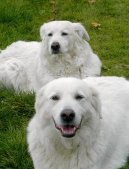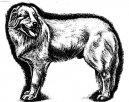Maremma and abruzzes shepherd dog (Dog standard)
The maremma and abruzzes shepherd dog is a big dog, strongly built of a rustic appearance, at the same time majestic and really typical.
FCI Standard N° 201 / 15.09.1992 / GB
MAREMMA AND THE ABBRUZES SHEEPDOG
(Cane da Pastore Maremmano-Abruzzese)
TRANSLATION : Mrs. Peggy Davis.
ORIGIN : Italy.
DATE OF PUBLICATION OF THE ORIGINAL VALID STANDARD : 27.11.1989.
UTILIZATION : Shepherd dog used mainly for the protection of
flocks and guarding of properties.
CLASSIFICATION F.C.I. : Group 1 Sheepdogs and cattledogs
except Swiss cattledogs.
Section 1 Sheepdogs.
Without working trial.
BRIEF HISTORICAL SUMMARY : This ancient breed of dogs who guard flocks comes from shepherd dogs actually still used in the Abruzzes where the breeding of sheep is still thriving even in these days, and sheepdogs which existed yesteryear in the region of the Tuscan Maremma and in that of Latium. Most especially since 1860, the seasonal moving of livestock from one region to another has favoured the developing of a natural crossing of those two primitive breeds.
GENERAL APPEARANCE : The Maremma and Abruzzes shepherd dog is a big dog, strongly built of a rustic appearance, at the same time majestic and really typical. On the whole his shape, of average proportions, is that of a heavy dog, whose BODY is longer than the height at the withers; is balanced as much in SIZE (heterometry = normal proportions between the SIZE and different parts of the BODY) as to the profiles (alloidism = concordance between the profiles of the HEAD and the BODY).
IMPORTANT PROPORTIONS : The length of the HEAD reaches the 4/10 of the height at the withers; the length of the muzzle is 1/10th less than that of the skull; the BODY length is more by 1/18th than the height at the withers.
Depth of thorax is slightly less than half the height at the withers. (For instance : for a dog of 68 cm the depth is about 32 cm).
BEHAVIOUR AND TEMPERAMENT : His principal function as a guard and defense dog of flocks and property in general, asserts itself in the manner he accomplishes these tasks, with perception, he can also show a devoted attachment to his master and all his entourage.
HEAD : On the whole, the HEAD is large and flat, of conical shape, reminiscing of that of a polar bear.
CRANIAL REGION :
Skull : Is of great width with lateral sides slightly bulging. In profile, is also convex. The upper longitudinal axes of the skull and muzzle are slightly divergent, which makes the profile of the HEAD slightly convex.
The superciliary arches are moderately marked. The medio-frontal furrow line is slightly marked. The occipital crest is only just visible.
Stop : The frontal-nasal depression only just accentuated and the frontal-nasal angle is always very open.
FACIAL REGION :
Nose : Rather big, in line of the muzzle, with large well-opened nostrils, moist and cool, COLOURed black. In profile must not protrude beyond the front marginal of the lips.
Muzzle : Its length is by 1/10th less than that of the skull. Its depth, measured at the level of the corner of the lips, must reach half its length. Its width decreases progressively according to the convergence of the lateral sides of the muzzle towards the front, but nevertheless keeping a flat fore surface. The suborbital region is slightly chiselled.
Lips : Seen from the front, the upper lips, at their junction point, determine by their lower edge a semicircle of very short radius. Slightly developed, they barely cover the teeth of the jaw, and, therefore, the corner of the lips is only lightly accentuated.
Consequently the lower lateral profile is only defined by the lips in its fore part, in its rear part it is defined by the lower jaw and the corner of the lips. The rims of the lips are black.
Jaws : Look strong, normally developed, with incisors set straight, well aligned of good SIZE and complete in number.
Teeth : White, strong – scissor bite.
Cheeks : Moderately visible.
Eyes : Not large in relation to the SIZE of the dog; the iris is of an ocre COLOUR or chestnut brown. The eye, in lateral position, is neither deep set nor protruding. Lively and attentive expression. Eyelid opening is almond shaped, with black eyelid rims.
Ears : Set very high over the zygomatic arches, they are hanging but very mobile. Triangular shape (in V), their extremities forming a narrow point never rounded; they are small in relation to the SIZE of the dog. For a medium SIZE dog their length must not go beyond 12 cm. The ear attachment is of medium width. Cropped ears tolerated only in dogs really used as herd dogs.
NECK : Upper profile moderately arched. Its length does not go beyond the 8/10 of the length of the HEAD, which means that the NECK is always shorter than the HEAD. It is thick, very strong muscular and always without dewlap; covered with long and dense HAIR forming a collar particularly obvious in males.
BODY : Solidly constructed, its length is more by 1/18 than the height at the withers.
Top line : Straight from withers to rump where it becomes somewhat sloping.
Withers : Slightly above from the topline; wide because of the distance separating the shoulder blades.
Back : Straight in profile, length reaches about 32% of the height at the withers. The loin which merges perfectly with the topline has a slightly curved profile with well developed muscled in width. The loin reaches in length 1/5 of the height at the withers and its width is nearly equal.
Croup : Wide, strong and well muscled. Its inclination from the hip to the TAIL set is of 20° increasing to 30° and more if we refer to the ileum-ischium line; that is why the rump of the Maremma and Abruzzes shepherd dog must be qualified as sloping.
Chest : Ample, descending to level of elbows, deep and well-rounded at mid-height. Its circumference must be more than ¼ of the height at the withers; its maximum width at mid-height must reach at least the 32% of the height at the withers, then decreases progressively downwards while retaining a good width in the sternal region. Its depth must reach half the height at the withers. The ribs are well sprung and oblique with inter-costal spaces of good width; the last false ribs are long, oblique and well opened.
Underline and Belly : The sternum-ventral profile is characterised by a long sternal line in the shape of an arc of a circle of very big radius rising slightly towards the belly.
TAIL : Low set due to the sloping rump, in normal stand reaching below the level of the hock. Hanging when dog stationary; carried level with back line with a rather strongly hooked extremity when the dog is in action. Well furnished with dense HAIRs without fringes.
LIMBS
FOREQUARTERS : Straight LIMBS from the front and in profile; FOREQUARTERS well balanced in relation to the BODY, and the various parts of the FOREQUARTERS are well proportioned between them.
Shoulders : Long, oblique with powerful muscles. Must be really free in MOVEMENT. In length measures about ¼ of the height at the withers. Its obliqueness below the horizontal is of 50° to 60°.
Upperarm : Set close to the BODY in its upper two thirds, with powerful muscles. Its obliqueness below the horizontal varies between 55° and 60°; its length measures about the 30% of the height at the withers. Its position is more or less parallel with the median plane of the BODY. The scapula-humeral angle varies between 105° and 120°.
Elbows : Normally close to the chest, they are covered with a soft loose SKIN. Their position must be parallel to the median plane of the BODY; the point of the elbow must be on an imaginary vertical line starting at the rear angle of the shoulder blade. The opening of the humeral-radial angle varies between 145° and 150°.
Forearm : Straight, and vertical, heavily boned. Its length is slightly more than the length of the upperarm, while being a little less of a third of the height at the withers. The front leg from ground to elbow measures 52,8% of the height at the withers.
Carpus (Carpal joint) : In extension of the vertical of the forearm. Strong, clean, smooth and of good thickness; the pisiform bone is clearly protruding.
Metacarpus (Pastern): Its length must never be less to 1/6 of the foreleg measured from ground to elbow. It is lean with a minimum of sub-cutaneous tissue. Seen in profile is slightly oblique towards the front.
FEET : Large, of roundish shape, well closed toes, covered with short thick HAIR, nails preferably black. Chestnut COLOUR is tolerated.
HINDQUARTERS : Seen as a whole : LIMBS straight when seen from the behind and in profile. The general aspect is in proportion with the BODY, and the various parts of the HINDQUARTERS are harmonious.
Thigh : Long, wide protruding muscles and a rear edge slightly convex. Its width, measured from edge to edge, reaches ¾ of its length. It is a little oblique from top to bottom and rear to front; the coxal-femoral (hip bone) angle is about 100°.
Second thigh : Its length, a little shorter than the thigh, corresponds to 32,5% of the height at the withers. Its obliqueness below the horizontal is about 60°. Strong bone, muscles lean and the groove in the leg well marked.
Knee : Perfectly in the vertical of the limb, without internal or external rotation. The fermoral-tibial angle rather well opened, varies between 135° and 140°.
Hock joint : Quite thick, with broad lateral faces. The angle opening varies between 140° and 150°.
Metatarsus (Rear pastern) : Strong, lean and broad. Its length reaches 30,9% of the height at the withers. Eventual dewclaws must be eliminated.
FEET : Like the front but more oval.
GAIT/MOVEMENT : Walk and extended trot.
SKIN : Tight to all parts of the BODY; rather thick. Black pigmentation of the mucous membranes, third eyelids as well as the central and toe pads.
COAT
HAIR : Very well furnished. HAIR long, rather harsh to the touch, closer to straight horse HAIR, flat to the BODY; slight wave is tolerated. The HAIRs form an important collar around the NECK and fringes of limited length on the edge of the HINDQUARTERS. But the HAIR is short on the muzzle, on the skull, the ears and front edge of the LIMBS. On the BODY the length of the HAIR reaches 8 cm. The underCOAT is only in winter abundant.
COLOUR : Solid white. Shades of ivory, pale orange or lemon are tolerated but only in certain limits.
SIZE AND WEIGHT :
Height at the withers : Males : 65 to 73 cm. Females : 60 to 68 cm.
Weight : Males : 35 to 45 kg. Females : 30 to 40 kg.
FAULTS : Any departure from the foregoing points should be considered a fault and the seriousness with which the fault should be regarded should be in exact proportion to its degree.
SEVERE FAULTS :
HEAD : Cranial-facial axes convergent, accentuated and disfiguring prognathism.
TAIL : Rolled over the back.
GAIT : Dog which paces continuously.
SIZE : Over or below the limits fixed by the standard.
ELIMINATING FAULTS :
Aggressive or overly shy.
Nose : Completely depigmented.
Muzzle : Definitely convex or concave.
Eyes : Moderate or bilateral depigmentation of the eyelids. Wall eye. Bilaterally cross-eyed.
Jaws : Undershot mouth.
TAIL : TAILless or short TAIL, whether congenital or docked.
COAT : Curly.
COLOUR : Isabella COAT; well defined patches or Isabella or ivory COLOUR. Black shadings.
Any dog clearly showing physical or behavioural abnormalities shall be disqualified.
N.B. : Male animals should have two apparently normal testicles fully descended into the scrotum.
Source: FCI >>> |



